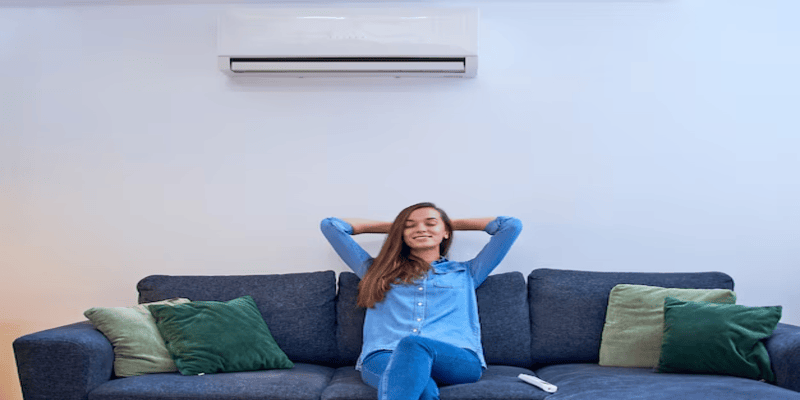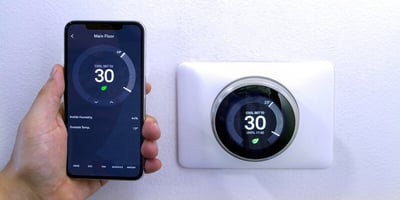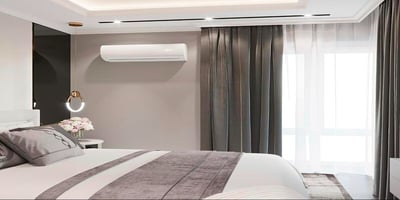Do Cats Need Air Conditioning in Summer? Comfortable Temperature For Cats
During intense heatwaves, many Siamese cats refuse to leave bathroom floor tiles for days straight. While humans might be uncomfortable despite fans working overtime, these clever felines find the coolest spots in the house and claim them as summer sanctuaries. This behavior raises an important question: “Do cats need air conditioning during hot weather, or can they manage on their own?”
Cats have earned their reputation for seeking warmth (evidenced by their attraction to sunny windowsills), but this doesn't mean they're immune to summer discomfort or heat-related health problems. Behind that independent attitude and plush fur coat is an animal that benefits from properly managed room temperature for cats, especially when outdoor thermometers climb into dangerous territory.
The relationship between cats and air conditioning is more nuanced than many pet owners realize. While these descendants of desert animals handle heat differently than humans do, modern indoor cats have adapted to climate-controlled environments and benefit from thoughtful temperature management. Different breeds have vastly different needs – hairless Sphynx cats lose body heat quickly while thick-coated Maine Coons might struggle more in high temperatures.
We will explore what veterinary experts recommend for keeping whiskered companions cool when summer temperatures soar beyond their comfort zone.
Understanding Your Cat's Temperature Needs
 More Than Just Fur: How Cats Handle Heat
More Than Just Fur: How Cats Handle Heat
You've probably noticed your cat sunbathing in spots that would make you uncomfortable. This isn't because they're impervious to heat—cats actually run hotter than humans all the time:
- Normal cat body temperature: 100.5-102.5°F (38-39.2°C)
- Normal human body temperature: 98.6°F (37°C)
This higher baseline temperature comes from their desert ancestry, but it creates a critical misunderstanding among pet owners. Cats don't have better cooling systems than humans—they have significantly worse ones.
This limited cooling ability makes cats surprisingly vulnerable to heat stress. When temperatures climb, they rely on:
- Finding cooler surfaces (tile floors, sinks)
- Grooming (evaporation provides minor cooling)
- Panting (inefficient and a warning sign when excessive)
- Reducing activity (conserving energy/heat production)
Which Cats Need Extra Temperature Consideration
Not all cats handle heat equally well. The following groups need extra consideration when it comes to summer temperatures:
|
Cat Type |
Heat Risk |
Why They're Vulnerable |
|
Seniors (10+ years) |
High |
Less efficient temperature regulation |
|
Brachycephalic breeds (Persians, etc.) |
Very High |
Breathing difficulties restrict panting |
|
Overweight cats |
High |
Extra insulation, reduced mobility |
|
Long-haired breeds |
Medium-High |
Thick coats trap body heat |
|
Kittens |
Medium |
Still developing temperature regulation |
|
Cats with heart/thyroid conditions |
Very High |
Compromised systems struggle with added heat stress |
The myth that cats are naturally equipped for heat because of their fur ignores how domestic cats have adapted to our climate-controlled homes. Modern indoor cats often lack the environmental adaptations their ancestors developed, making proper room temperature for cats a genuine health concern rather than just a comfort preference.
The Importance of Air Conditioning for Cats
Why an Air Conditioner for Cats is More Than a Luxury
Indoor temperatures can quickly become dangerous for cats even when outdoor conditions seem merely warm rather than scorching. This happens because:
- Homes trap heat, often reaching temperatures 10-15°F higher than outdoors
- Limited airflow reduces cooling opportunities
- Sunlight through windows creates hot zones that persist for hours
- Modern insulation designed to keep homes warm in winter also traps summer heat
Most pet owners don't realize that fans provide minimal relief for cats compared to humans. "Fans work for humans because they accelerate the evaporation of sweat from our skin," explains veterinarian Dr. Mark Thompson. "Since cats barely sweat, fans do little to cool them beyond providing some air circulation"
The effectiveness of cooling methods for cats:
|
Cooling Method |
Effectiveness for Cats |
Why |
|
Open windows |
Low-Medium |
Provides fresh air but may not lower temperature |
|
Fans |
Low |
Minimal effect on cat's body temperature |
|
Cold surfaces |
Medium |
Temporary relief but doesn't cool ambient air |
|
Cats air conditioning |
High |
Consistently lowers ambient temperature |
|
Cooling mats |
Medium |
Helps individual cats but not at room temperature |
Studies have found that cats living in homes without air conditioning show measurable signs of heat stress when indoor temperatures exceed 85°F (29.4°C) for extended periods. These include elevated heart rates, reduced activity, and changes in respiratory patterns—all before obvious symptoms of heat distress appear.
For multi-pet households, the problem compounds. Multiple animals create additional body heat in enclosed spaces, raising the temperature further. Without proper cooling, this can create a dangerous feedback loop where the environment becomes progressively warmer.
The benefits of air conditioning for cats extend beyond immediate comfort:
- Prevents dehydration (cats drink more when overheated)
- Reduces risk of heat-related illness
- Maintains normal activity levels and eating habits
- Prevents sleep disruption due to heat discomfort
- Creates a stable environment for cats with health conditions
As extreme weather events become more common, creating a controlled indoor environment isn't just about comfort—it's increasingly a health necessity for feline companions.
What is the Ideal Room Temperature for Cats in Summer?
 Finding the Perfect Temperature Range
Finding the Perfect Temperature Range
Most veterinary experts recommend keeping indoor temperatures between 75-78°F (24-26°C) for cats during the summer months. This range sits a few degrees warmer than human preference but accommodates cats' naturally higher body temperature while preventing heat stress.
Research from UC Davis Veterinary Medicine identified significant variations between individual felines. Thick-coated Maine Coons might show discomfort at 78°F while hairless Sphynx cats could seek warm spots at the same temperature.
Feline behaviorist Jackson Galaxy suggests: "Consider dropping nighttime temperatures a few degrees lower when cats are naturally more active and generating additional body heat."
Beyond Temperature: Other Comfort Factors
Humidity Levels: High humidity dramatically reduces cats' cooling efficiency. In humid climates, setting temperatures 2-3°F lower helps compensate for reduced evaporative cooling.
Air Movement: Proper ventilation prevents temperature stratification where hot air collects near ceilings. While fans provide minimal direct cooling for cats, they help maintain consistent temperatures throughout living spaces.
Microclimate Options: Temperature variations throughout the home let cats self-regulate. Providing access to cooler surfaces (tile, bathtubs) and warmer spots (sunny windowsills, cushioned beds) allows natural thermoregulation even within air conditioning environments.
How Different Cats Experience Temperature
Age Factors
Temperature sensitivity changes throughout a cat's life:
- Kittens: Limited temperature regulation requires warmer environments (76-78°F)
- Adult cats: Broader comfort range (75-78°F)
- Senior cats: Often need warmer settings as metabolism slows (76-78°F)
Coat Considerations
Coat type creates substantial differences in temperature preference:
- Long-haired breeds: Often prefer cooler temperatures (75-76°F)
- Short-haired breeds: Comfortable in mid-range temperatures (76-77°F)
- Hairless breeds: May need warmer settings or additional warmth options (77-78°F)
Health Status
Medical conditions significantly alter temperature needs:
- Hyperthyroidism: Lower temperature preference due to elevated metabolism
- Arthritis: Warmer environments reduce joint stiffness
- Obesity: Cooler settings compensate for additional insulation
- Respiratory conditions: Moderate temperatures with excellent ventilation
How to Tell if Your Cat Is Overheating
Cats typically hide discomfort until situations become severe—an evolutionary trait that masks vulnerability. This makes detecting early signs of heat stress crucial for cat owners.
Early Warning Signs
Watch for these subtle indicators that your cat may be too warm:
- Seeking cooler surfaces – When cats abandon favorite resting spots for tile floors, bathtubs, or sinks
- Changed positioning – Sprawling out with limbs extended rather than the typical curled position
- Decreased activity – Unusual lethargy or reluctance to play
- Increased water consumption – More frequent visits to the water bowl
- Elevated grooming – Excessive licking to create cooling through evaporation
These behaviors indicate your cat is actively trying to cool down and might benefit from air conditioning or other cooling interventions.
Moderate Heat Distress
As temperatures rise or exposure continues, cats show more pronounced signs:
- Panting – Unlike dogs, panting in cats is never normal except immediately after intense activity
- Restlessness – Inability to get comfortable, frequently changing positions or locations
- Sweaty paws – Damp paw prints on cool surfaces (one of the few places cats sweat)
- Rapid breathing – Breathing that appears faster than their normal respiratory rate
- Redness of ears and paw pads – Increased blood flow to these areas in attempts to dissipate heat
At this stage, immediate cooling measures should be taken, including adjusting the room temperature for cats to the lower end of their comfort range.
Severe Heat Stress: Emergency Warning Signs
The following symptoms require immediate veterinary attention:
|
Warning Sign |
What It Means |
Action Required |
|
Excessive panting |
Respiratory system in distress |
Immediate cooling and veterinary care |
|
Bright red tongue/gums |
Advanced heat stress |
Emergency veterinary visit |
|
Vomiting |
Body systems shutting down |
Immediate professional care |
|
Stumbling/incoordination |
Neurological impact of heat |
Emergency situation requiring immediate veterinary attention |
|
Lethargy/unresponsiveness |
Critical condition |
Immediate emergency care |
"Never wait until these severe signs appear," warns emergency veterinarian Dr. Carlos Rodriguez. "Begin cooling measures on the way to the clinic – wet towels applied to the neck, armpits, and groin, but avoid ice-cold water which can cause shock."
Risk Factors for Heat Sensitivity
Certain cats require extra monitoring during warm weather:
- Brachycephalic (flat-faced) breeds like Persians and Himalayans have compromised breathing efficiency
- Overweight cats have additional insulation and generate more body heat
- Very young or senior cats have less efficient temperature regulation
- Cats with heart conditions experience additional strain during heat exposure
- Cats taking certain medications may have altered temperature regulation (consult your veterinarian)
Prevention Through Observation
The most effective approach combines appropriate cats air conditioning settings with regular observation. Monitor water intake, activity levels, and breathing patterns during hot weather. These observations help identify your cat's specific comfort needs and catch problems before they escalate.
The best indicator is often comparative behavior. Trust your instincts – you know your cat best.
Practical Tips for Keeping Your Cat Cool Beyond Air Conditioning
 While air conditioning for cats provides the most reliable cooling, supplementary methods can enhance comfort, especially during extreme heat events or power outages. These practical tips work alongside climate control to create an optimal environment for feline comfort.
While air conditioning for cats provides the most reliable cooling, supplementary methods can enhance comfort, especially during extreme heat events or power outages. These practical tips work alongside climate control to create an optimal environment for feline comfort.
Hydration Strategies
Proper hydration forms the cornerstone of heat management for cats:
- Multiple water stations – Place water bowls throughout your home to encourage drinking
- Flowing water sources – Many cats prefer moving water; consider pet fountains that continuously circulate and aerate water
- Ice cube enrichment – Add ice cubes to water bowls (some cats enjoy playing with and licking them)
- Wet food incorporation – Increase wet food during hot periods to boost moisture intake
- Water bowl placement – Position away from food bowls and in quiet locations cats prefer
Creating Cooling Zones
Strategic environmental modifications can create comfortable microenvironments:
- Elevated resting spots – Higher areas catch better airflow
- Ceramic tile access – Preserve some uncovered tile areas rather than wall-to-wall carpeting
- Bathroom access – Tile floors and porcelain fixtures naturally stay cooler
- Shaded retreats – Ensure window perches have partial shade options
- Cross-ventilation pathways – Create airflow channels between windows or vents
Cooling Products Worth Considering
Several commercial and DIY options can supplement your cats' air conditioning setup:
|
Cooling Option |
Benefits |
Considerations |
|
Cooling mats |
Provide immediate relief, no electricity needed |
Some cats dislike the texture or sensation |
|
Elevated hammock beds |
Increase airflow around the body |
May not appeal to cats who prefer enclosed spaces |
|
Damp towel-draped carriers |
Creates a cooling tent effect |
Monitor humidity and replace towels frequently |
|
Freeze-pack wrapped blankets |
Provides localized cooling spots |
Never apply directly to skin; always wrap in fabric |
|
Window reflectors/films |
Reduces indoor heat gain |
Installation may temporarily disturb cats |
Grooming Approaches
Proper coat maintenance significantly impacts a cat's ability to regulate temperature:
- Regular brushing removes loose fur that would otherwise trap heat
- Mat prevention is crucial as matted fur creates insulating pockets against the skin
- Professional grooming for long-haired breeds may include seasonal trimming (never shave cats completely as fur protects from sunburn)
Activity Management
Adjusting playtime and exercise during hot weather helps prevent overheating:
- Schedule interactive play sessions during cooler morning or evening hours
- Choose lower-intensity play methods during heat waves
- Recognize when your cat is limiting activity to conserve energy/reduce heat production
- Create mentally stimulating activities that don't require physical exertion (food puzzles, window viewing)
Heat Wave Emergency Preparation
For extreme weather events or air conditioning failures:
- Keep battery-powered fans available
- Prepare frozen water bottles wrapped in towels for emergency cooling
- Identify the coolest room in your home (usually basement or north-facing rooms)
- Know your veterinarian's emergency protocols and the location of the nearest 24-hour facility
- Consider a battery backup system for essential cooling if you live in an area prone to outages
The combination of proper room temperature for your pets through air conditioning plus these supplementary techniques creates the most resilient approach to summer heat management.
Leveraging Technology for Optimal Cat Comfort
Smart climate control systems offer significant advantages for maintaining the ideal room temperature for cats throughout changing conditions. Here's how Sensibo's technology specifically benefits feline comfort:
Temperature Precision and Stability
Cats like consistency, and Sensibo maintains significantly tighter temperature tolerances than conventional systems. This stability reduces stress for sensitive cats and creates a more comfortable environment, especially for seniors and those with health issues.
Remote Monitoring and Control
Monitor and adjust your home's climate from anywhere:
- Change settings during unexpected weather events
- Check actual home conditions rather than just programmed settings
- Adjust for seasonal changes without disrupting your cat's routine
Smart climate control doesn't just make air conditioning for your cat more effective but also makes it more responsive to both the environmental changes and the animals' needs.
Customized Scheduling
Align temperature settings with your cat's natural activity patterns:
- Cooler temperatures during active morning and evening hours (75-76°F)
- Slightly warmer settings during midday rest periods (76-77°F)
- Customized overnight settings based on your cat's specific patterns
For multi-cat households, this flexibility proves particularly valuable. Different temperature zones accommodate varying needs—cooler areas for thick-coated breeds and warmer spots for hairless or senior cats.
Practical Benefits
Beyond comfort, smart climate control offers practical advantages:
- Energy efficiency and cost savings
- Early detection of potential HVAC problems
- Improved air quality through better filtration monitoring
- Balanced humidity levels that benefit respiratory health
When implementing a smart system, position temperature sensors away from direct sunlight and consider the areas where your cats frequently rest. With minimal setup, these systems create consistent, comfortable environments that enhance feline wellbeing year-round.
Take Care of Your Cat in the Summer
So, should you blast the AC for your cat this summer?
The evidence suggests yes. Despite their desert ancestry, house cats benefit from temperatures between 75-78°F during hot weather. Their limited cooling mechanisms (those tiny sweat glands only in their paws) make them surprisingly vulnerable when temperatures climb.
The "set it and forget it" approach doesn't work well for feline comfort. Temperature needs change throughout the day, with season shifts, and even as your cat ages. Smart climate systems like Sensibo adapt to these changing requirements without constant manual adjustments.
Watch your cat—they'll tell you what they need. Excessive grooming, seeking tile floors, or unusual lethargy are all conversations about temperature, just without words. These behavioral signals often appear before obvious distress.
Fans, cooling mats, and increased water stations complement your air conditioner for cats, creating a comprehensive cooling strategy that works even during extreme heat events.
The cost of running your air conditioner is trivial compared to an emergency vet visit for heat stroke. Your cat's health—and your peace of mind—are worth the investment in maintaining appropriate room temperature for cats year-round.






































